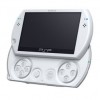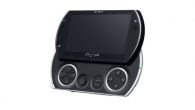The PSPgo is the latest PSP model from Sony, released on October 1st 2009. The PSPgo is the smallest and lightest PSP yet, weighing in a just 160g. It’s 50% smaller and 40% lighter than the original PSP (PSP-1000). We’ve been playing with the PSPgo for a couple of days now and though it was about time we share out thoughts. In short, the new model is great but there are a few short-comings.
The PSPgo is beautiful – its small, and slick and fits perfectly into your pocket, unlike the older PSPs. The unit itself is slightly bulkier than the iPhone and the smaller screen makes the graphics look sharper. The PSPgo screen supports the same resolution (480 x 272) as the older models but is physically smaller. However, just like the older models, playing in direct sunlight is still a no-go. One useful addition is BlueTooth connectivity, allowing you to access the Internet via BlueTooth modems and mobile phones.
The controls are tucked away behind a slide-up screen, much like the T-Mobile G1 mobile phone, though it feels much stronger. The actual controls are also much smaller too. The analogue nub is only about a centimeter in diameter, and even the face buttons are smaller (less than a centimeter in diameter). The screen brightness button, volume control and music buttons have been relocated to the top of the PSPgo. The power switch is on the right-side as always and the Wi-Fi switch has returned to the left-side.
As the unit is smaller, the controls are also closer together. After playing a few hours straight on the PSPgo, we can conclude that the controls work well. The closeness of the controls make gaming more comfortable. The trigger buttons can be a bit annoying to press at times as they are located very closely to the back of the screen. The volume buttons are also a pain to get to when the screen is up.
 The PS button and trigger button are the only controls exposed when the unit is closed. Watching a movie or listening to music, the trigger buttons can be used to skip to the next / previous item, allowing you to keep the other controls hidden. The proprietary headphone slot has been replaced with a normal headphone jack so your older PSP remotes and video-out cables can no longer be used. The standard USB shot, however, has been replaced with a proprietary port, doubling as the AC adapter port too.
The PS button and trigger button are the only controls exposed when the unit is closed. Watching a movie or listening to music, the trigger buttons can be used to skip to the next / previous item, allowing you to keep the other controls hidden. The proprietary headphone slot has been replaced with a normal headphone jack so your older PSP remotes and video-out cables can no longer be used. The standard USB shot, however, has been replaced with a proprietary port, doubling as the AC adapter port too.
The PSPgo is Sony’s answer to a all-digital future. The UMD drive has been removed from the PSPgo and replaced with 16GB of Flash Memory. Games can only be loaded on to the PSPgo via the PlayStation Store, which also removes some of the piracy issues. If you are a existing PSP owner, this is the first thing that will put you off. Your existing library of UMD games and movies is now unusable – in fact, if you want to play those games again, you will have to buy them again via the PlayStation Store.
Sony will continue to make UMD games but for how long? Most future games will be available in both UMD and digital download formats, but it’s likely that games will soon move to digital-download only. The PSPgo is perfect as you can buy games from the comfort of your home or even on the go – the PlayStation Store can be accessed via the PSPgo or from a PC and PS3. But, if you prefer to have your games on a disc, then its clear that the PSPgo isn’t for you.
With the PlayStation Store, however, there are some major issues related to the PSPgo – the biggest of which is pricing. Digital distribution is naturally cheaper as you don’t have the associated packaging and distribution costs of retail games, but Sony doesn’t seem to think so. PSP games on the PlayStation Store are priced the same as their retail counter-parts and in some cases even more. Take Gran Turismo PSP for example. On the store, its will cost you £21.99 to download, but if you visit Play.com, you can get the same version on UMD for only £17.99. Stupid right?
Another short coming is the download speed. The PSPgo, like the older models, only has 802.11b Wi-Fi functionality, which means you can only download content at a slow 11Mbps. If you happen to have blazing fast broadband, the PSPgo will not make full use of the available speed. You’re better off downloading the game to your PS3 or PC and then transferring it to your PSPgo. This obviously hinders the portability of the PSPgo somewhat, but then at lease you have a backup of the game. The 802.11b functionality is a huge step backwards by Sony. It’s 2009 (almost 2010) – all new Wi-Fi devices have at least 802.11g or even 802.11n. With the PSPgo only supporting digital distribution, you think Sony would have at least though of this.
 One welcome addition is BlueTooth connectivity. As we mentioned above, with Firmware 6.10 you can access the internet using a BlueTooth model, Personal Area Network (PAN) or even a mobile phone (e.g. iPhone via Tethering). This means you can play online games on the go, for example, http://mobile.partybets.com, on the tube using your mobile phone. The BlueTooth connectivity also allows you to pair the PSPgo with a PS3 Controller. You can fully control and play games using a PS3 controller, which is particularly useful when outputting video to a TV.
One welcome addition is BlueTooth connectivity. As we mentioned above, with Firmware 6.10 you can access the internet using a BlueTooth model, Personal Area Network (PAN) or even a mobile phone (e.g. iPhone via Tethering). This means you can play online games on the go, for example, http://mobile.partybets.com, on the tube using your mobile phone. The BlueTooth connectivity also allows you to pair the PSPgo with a PS3 Controller. You can fully control and play games using a PS3 controller, which is particularly useful when outputting video to a TV.
The ability to use a PS3 controller is great, but you wouldn’t catch us playing the PSPgo on the train using a DualShock 3 controller. Especially since the controller itself is larger than the PSPgo! But its nice to have the option there in case it’s needed. It will sure make playing those PSOne titles a lot easier. You can also make use of the rumble features too.
One of the major disadvantages of the new PSP is the price. It’s only £25 cheaper than the PSP Slim! If Sony are expecting a high uptake of the new model, this isn’t the way to go. The original PSP sold for £179 back in 2005 and the PSP-3000 was £150 when it was released. £225 is way too much for the PSPgo – flash memory or not. It should be £180 at max – or not a lot of people will buy one, especially when it means losing the ability to play older UMD titles and making all those accessories unusable, including the Go!Cam, Microphone, and GPS devices.
Conclusion
The PSPgo is definitely a great addition to the PlayStation family, but it is likely to struggle in the market. Sony is making a bold decision in removing the UMD drive and moving to digital-only distribution, but it’s clearly the future. We expect most existing PSP owners to stick with their older PSP just to make use of their UMD library, which is fair. Without a decent reward program, not a lot of people will want to give up their UMD games. Though its good to know that you can get three free games from the Store if you register your PSPgo and old UMDs before March 2010, but its only for participating countries in the EMEA (Europe, Middle-East and Africa) area.
Out of five stars, we give the PSPgo a solid four (4 out of 5). The unit does have short-comings, such as the slow Wi-Fi, but the new additions make up for it. Namely, BlueTooth connectivity, the sleek design and 16GB of flash storage. Lets just hope Sony reduce the price to make it more affordable and reward loyal PSP gamers for upgrading.


fresh psp geting one